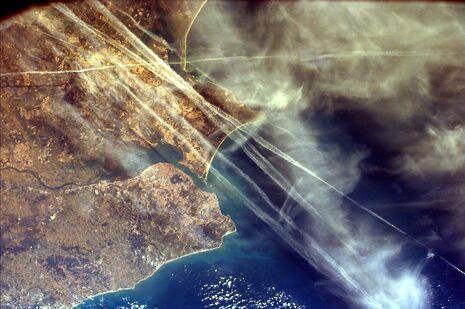Rigging the climate on purpose
How scientists hope to tackle the complex ethical and technical challenges surrounding geoengineering

The fight to keep global average temperature increases to 1.5°C as outlined in the 2015 Paris Agreement seems like a distant pipe dream for many as across Europe hottest temperature records are being set. This agreement was further undermined by Donald Trump announcing in 2017 that the US would be leaving the accord, claiming that it was not in its economic interest.
In a world where an economy's health is largely accounted for by its GDP, the challenge of introducing pro-environment policies feels impossible considering the reliance of whole industrial sectors on fossil fuels. It appears progress toward a greener world is mostly only possible in areas where investments in infrastructure can support radical changes, such as breakthroughs in electric vehicle technology allowing for France's ban on petrol or diesel cars by 2040. But this cannot be said for many industries.
Many believe we have reached the point where cutting down emissions and pollution is simply not enough and that active efforts in reversing damage are needed. Currently we are emitting greenhouse gases such as carbon dioxide and methane at an increasing rate into our atmosphere. This has the effect of creating a blanket around the world. It allows electromagnetic radiation from the sun in, due to its shorter wavelength. It then hits the Earth and raises its temperature, and the Earth radiates it back towards space but with a much longer wavelength. The blanket of greenhouse gases can absorb longer wavelengths and radiate some of it back to Earth. The net effect is a global increase in average temperature.
Paul Crutzen explored a quite different approach to tackle this problem in his editorial essay, ‘Albedo Enhancement by Stratospheric Sulphur Injection’. The Earth’s albedo is the ratio of diffusely reflected light to the total incident light on the Earth. The idea of enhancing the Earth’s albedo would artificially reduce the amount of radiation reaching the surface, decreasing the amount of energy absorbed by greenhouse gases.
Earth has two major sources of reflection: ice and clouds. Our ice is melting, and this at faster rates, lowering the Earth’s albedo. Increasing ice coverage on the Earth would be very difficult. To make matters worse, urban areas also decrease the Earth’s albedo due to the reduction in natural reflection and increase in heat-absorbing materials leading to the urban heat island effect. This leaves us with a second, potentially more fruitful option. Clouds are aerosols, a suspension of solid or liquid particles in a gas. Sulphur can be used to form cloud condensation nuclei, that is, the seed from which water in the atmosphere can condense on and then produce clouds. By using these particles in the atmosphere we can increase the likelihood of cloud cover and artificially increase the Earth’s albedo.
Paul Crutzen’s essay was published in 2006 and now thirteen years later, the idea is soon to be trialed. Researchers at Harvard University have developed innovative techniques using calcium carbonate as reflective particles which can be dispersed in the atmosphere to increase the Earth’s albedo. The notable difference here is that the previous sulphur-based sunlight reflection was also having a damaging effect on human health and the environment as a pollutant.
Blocking more sunlight could help plant growth by reducing heat stress, but may detrimentally impact photosynthesis. Whilst the Harvard experiment is perhaps the first to be labelled a solar geoengineering project, there have been other related experiments, like the Eastern Pacific Emitted Aerosol Cloud Experiment (EPEACE), a study which discusses how cargo ships could be seen as carbon neutral given that their smoke could increase the albedo of the clouds enough to offset their contribution of CO2 to the atmosphere. “...[I]f half of the open-ocean transit days of a cargo ship result in tracks that are on average 15% brighter than the surrounding clouds and cover 2,500 km2 , then cargo ship transit (for consumables only) could be considered ‘carbon neutral’”, the study wrote.
What are the next steps for the Harvard experiment? Besides the required research, modelling and calculations, the study faces another challenge to tackle: ethics. Given the technologies’ novelty, the scientists involved are concerned by the potential for protests of environmental activists against their research, and thus have formed an advisory panel to oversee this project. Their commitment to scientific ethics from the beginning shows foresight, duty of care and diligence hopefully accelerating the experimentation phase. With this in place, the future for the Stratospheric Controlled Perturbation Experiment (SCoPEx) is full of preliminary testing and modelling to ensure the controllable balloon dispersing the calcium carbonate (or other chemicals) works.
While the SCoPEx project offers hope, it must be said that it is very much treating the symptoms of the problem and not the root causes. Improvements in undoing the damage we have done to the climate should not be an excuse to slow the research and collective effort in battling the causes.
As an individual it can seem impossible to have a true impact, but it will be through collective, imperfect action on a large scale that we truly make a difference. It fills me with hope that scientific research like SCoPEx is being funded as well as other innovative solutions to climate change, but there is still a long road ahead for all of us.
 News / SU stops offering student discounts8 January 2026
News / SU stops offering student discounts8 January 2026 News / Uni-linked firms rank among Cambridgeshire’s largest7 January 2026
News / Uni-linked firms rank among Cambridgeshire’s largest7 January 2026 Comment / Plastic pubs: the problem with Cambridge alehouses 5 January 2026
Comment / Plastic pubs: the problem with Cambridge alehouses 5 January 2026 News / New movement ‘Cambridge is Chopped’ launched to fight against hate crime7 January 2026
News / New movement ‘Cambridge is Chopped’ launched to fight against hate crime7 January 2026 Comment / What happened to men at Cambridge?31 December 2025
Comment / What happened to men at Cambridge?31 December 2025









